| Old Town Sidewalk Astronomers | |
Observing Report from the 2005 Oregon Star PartySeptember 1-3, 2005Jane Houston Jones |
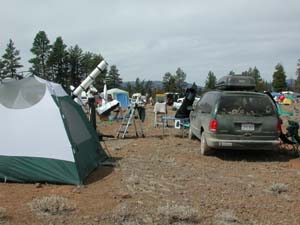
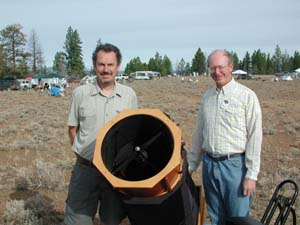
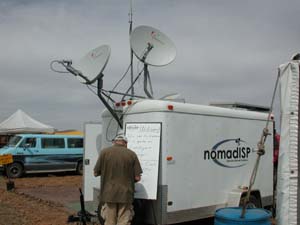
2005 has been good to us, star party-wise. We enjoyed the winter monthly star parties of the Andromeda Society in Southern California's High Desert. The Grand Canyon Star Party was grand in June. Glacier Point in California's Yosemite National Park was breath-taking in both July and August. We joined fellow club members of the SFAA and the SJAA at the club's annual national park public service star parties during the summer new moon weekends. To cap off the summer we made our first 1,000-mile (that's one-way mileage) trek from Southern California to the Oregon Star Party in September.
The OSP is one of the finest star parties we've attended. Occasional magnitude 7 skies and spectacular transparency combined with a real chuck wagon, showers and a coffee vendor made for pleasant nights and days alike. Nomad ISP wireless internet took care of the needs of my inner geek.
The success of the Oregon Star Paty is a tribute to both the dark skies and the dark sky wranglers who put this event together each year. I have nothing but huge praise for all the "Oregonizers" and the cadre of tie dye shirt-clad volunteers. Thanks everyone! These include Larry Godsey, OSP Director, Chuck and Judy Dethloff, who we bumped into again and again each day, sometimes at breakfast, or sunset and even near dawn at the eyepiece. Then there was Bob McGown. After a long discourse with Bob (when I was trying to collimate our reflector), I showed him my current project for the night- continued work on my 7th Astronomical League observing project Observe Galaxy Groups and Clusters . Bob and Miles Paul wrote the book. When I took the book off my observing ladders "paint shelf" it opened to Bob's picture. And that's a true story! Galaxy clusters observed on the two nights: AGC 119, 76, 14, 3744, 2593, 2589, 2634, 2666, Hickson 28, 15, 86. That'll be a separate report, and I hope to be submitting my completed paperwork for the pin sometime soon.
It took me a while to adjust to southern California after returning from the beautiful high desert and pristine skies of Central Oregon. Pristine, when not combined with earthly atmospheric nuisances such as rain or forest fires. Luckily, both were politely refused admittance at the OSP registration tent this year. Clouds were a minor nuisance during some parts of some nights, but didn't hinder my observing too much.
Many people commented on the great number of meteors they saw on the night of September 1 and 2. There were no major meteor showers. September's rates are poor in comparison to August's mighty Perseids. So what was going on?
Some meteors I noticed came from the direction of the Anthelion Radiant - think anti-helion or opposite the sun direction. Unlike most of the annual showers the antihelion source is produced by debris from unknown objects orbiting in a direct motion like the earth. These objects are most likely asteroids, which produce stony and metallic debris whose density is much greater than material produced by comets. There is also the possibility that some of this activity may be caused by the Jupiter family of comets, comets which have been altered by Jupiter's gravity into much shorter orbits.
This material collides with the earth on the inbound portion of its orbit, before its closest approach to the sun. We see the meteors just after midnight when we are facing the direction from which this activity appears. The antihelion source is active all year from an area of the sky nearly opposite that of the sun. The meteors are actually moving slightly faster than our planet and enter the atmosphere after they have caught up to Earth. Here's more information on the anthelion radiant.
The sporadic rates for the northern hemisphere rise toward their high plateau for the year in September. The numbers of sporadic meteors vary from season to season, due to the tilt of the Earth on its axis and other factors. As a general rule, about 2 to 3 times as many sporadic meteors can be seen in the early fall as can be seen in the early spring. So this explains the greater number of meteors this time of year - the dark skies helped, too.
On the second night, September 2 and 3 I was busy looking at objects from my current project, the Astronomical League's Observe Galaxy Groups and Clusters, while waiting for Mars to rise higher in the morning sky. I noticed many of these faint clusters of galaxies were eluding me after a while. Was I just tired? What was going on? To the north, I noticed a light dome, except there are no earthly sources of this much pollution nearby. Then it dawned on me. I was facing north, looking towards Ursa Major and Ursa Minor. I was looking at airglow, a faint diffuse illumination of the night sky originating in the upper atmosphere.
Airglow is more subtle than an aurora. The energy in the form of visible light is derived from the sun's ultraviolet light, which ionizes atoms and dissociates molecules at heights between 40 and 200 mi (64 - 322 km) above the earth's surface. When the fragments collide and recombine, some atoms and molecules are left with excess energy, which they release as light. Well, that would explain it - I was seeing airglow. Suddenly I wasn't so annoyed. In fact, it was an exciting observation. It was time to look at Mars anyway.
We spent quite a bit of time observing Mars and our sketches are here on both nights, and lots of the other attendees stopped by for a 400x look at the red planet. We hauled our f/9 Astro-Physics 180EDT refractor to Oregon, and I think it was the only AP 7-inch refractor in a vast sea of fine telescopes of all sizes. The seeing and transparency were so outstanding on our first observing night that we were able to view Mars at over 800x with rock steady images near dawn. The early evening was cloudy and many slept through this best of the three nights. We took a nap until 2 a.m. hoping for the skies to clear, which they did, leaving us with 3 perfect hours. The skies were even better earlier in the week for those who arrived earlier, we heard.
We had several visitors who stopped for looks through both telescopes, and a few stayed with us for more than an hour each night. One of our guests sat in our comfortable observing chair, asked questions and scanned the Milky Way using my favorite binoculars: my old 10 x 50 Carton Alderblicks. She asked if she could use our reflector for a while, and soon she was surfing the Milky Way, while I was sketching Mars through the refractor. She spotted the beehive cluster, M44 below Saturn!
Finally near dawn, another glow appeared. A triangular glow of light extended up about 35 degrees from the horizon past Saturn and on to Mars. Sunlight bounced off grains of dust in the plane of our Solar System, starting at the horizon and lighting the ecliptic plane. The zodiacal light!
Jupiter and Venus graced the sunset sky at dusk. The zodiacal light, Mars and Saturn and even a slender crescent moon and Mercury welcomed the approaching dawn. What punctuation to mark a great star party experience.
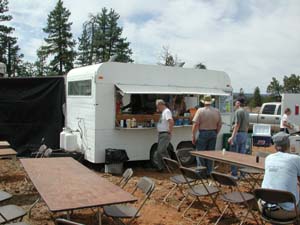
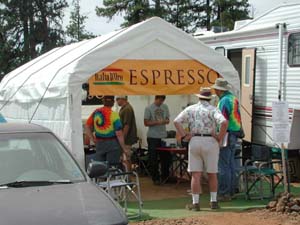

Date September 1-3, 2005
Location: Location: Ochoco National Forest, Oregon
Altitude: 5,000 feet
Latitude: 44°N
Longitude: 120°W
Seeing: poor with moments of better than poor 2/5
Limiting magnitude using area 6 Alpha And, Gamma and Alpha Peg LM 7.0 - but not all night either night. 6.0 to 6.8 when I took the time to count stars.
Equipment:
Litebox reflector: f/5.75 14.5-inch at 96X with 19 Panoptic and higher,
Astro-Physics Starfire refractor f/9 7.1-inch (180mm EDT), 6&10mm Zeiss Abbe Ortho eyepieces and 16MM Televue Panoptics in 2.4x AP Barcon plus AP Baader Binoviewer 200-300x to 800X
Copyright © 2005 Jane Houston Jones
Last updated: